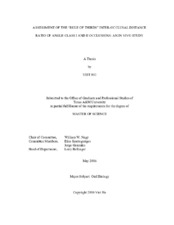| dc.description.abstract | When treatment planning an increase in VDO a dental articulator is used to orient the maxillary and mandibular casts in centric occlusion. The incisal pin can be raised to increase the proposed VDO. This results in more inter-occlusal distance between the anterior teeth than the posterior because of the “arc of closure”. Several studies have mentioned this variation in inter-occlusal distance in the posterior teeth compared to the anterior teeth, specifically at the molar region and central incisors. Rebibo et al, proposed a “Rule of Thirds” explaining that for the same vertical variation, molar height, incisal edge and anterior pin are proportional. The “Rule of Thirds” states that for a 3mm increase at the incisal pin, we obtain a 2mm increase at the incisors and 1mm increase between molars.”
The purpose of this in vivo study was to:
1. Evaluate the validity of the “Rule of Thirds” for facebow-mounted casts on a dental articulator.
2. Assess differences between Angle Class I and II occlusions.
The null hypothesis was there would be no statistically significant difference in the findings of this study and previous studies regarding the “Rule of Thirds”, and there would be no statistically significant difference in the “Rule of Thirds” between Angle Class I and II occlusions.
Thirty participants were selected and impressions of the maxillary and mandibular arches were made with irreversible hydrocolloid. A facebow record was made and casts were mounted in centric relation on a SAM 3 dental articulator. The interocclusal distance at the second molar was set at 1mm, and measurements at the central incisors, and incisal pin were recorded for data analysis.
Within the limitation of this in vivo study, the following conclusions can be drawn:
1. There was no significant difference between the findings of this study and previous studies regarding the “Rule of Thirds”.
2. There was no significant difference in the incisal vertical point, incisal horizontal point, and incisal pin point, between Angle Class I and II occlusions.
3. The inter-occlusal distance ratio of the second molar to the vertical overlap of the central incisor and incisal pin was approximately 1:1.8:2.9 on the SAM 3 articulator.
4. The inter-occlusal distance ratio of the second molar to the horizontal overlap of the central incisor was approximately 1:0.8. | en |


